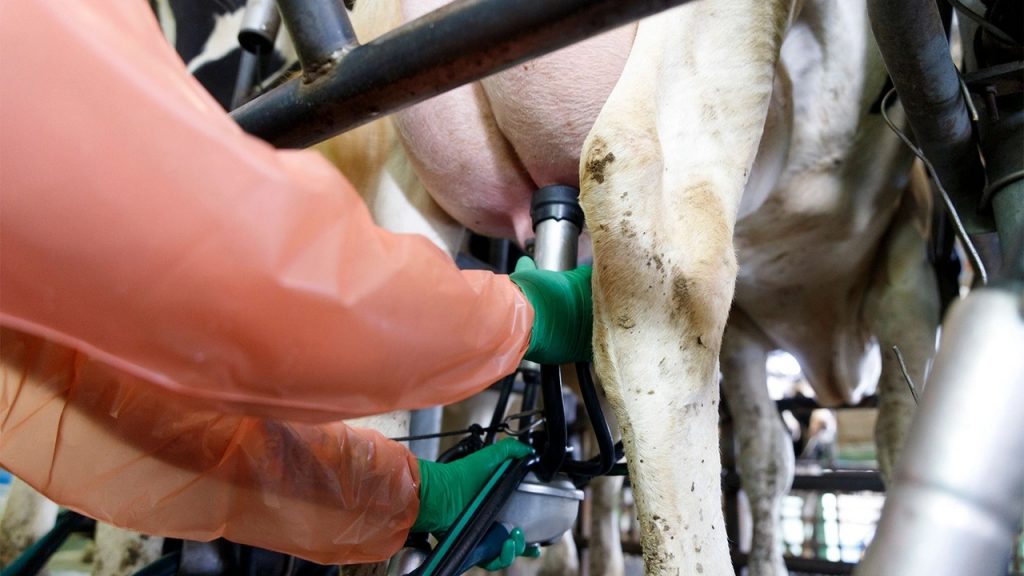
Eighteen farms in New York were selected for a project looking at herd health, disease diagnosis, protocols and record-keeping practices.
Following best practices to keep his dairy herd healthy has value beyond the farm for Tyler Beck. He prioritizes public outreach, posting regularly to social media about activities on the farm and hosting tours.
He was even featured in Roku’s “Dairy Diaries” series this spring.
“We want the public to realize that our animals represent our entire business and that we strive to give them the utmost care each day,” Beck says.
Beck’s farm was one of 18 selected for a project looking at herd health, disease diagnosis, protocols and record-keeping practices in New York. The project is a partnership between New York Farm Viability Institute and Cornell Cooperative Extension, with funding provided by USDA.
Betsy Hicks, dairy specialist with Cornell Extension, and Lindsay Ferlito, dairy welfare specialist with Cornell Pro-Dairy, collected data from the 18 farms to develop a benchmarking tool for herd health management.
Participating farms had to have computerized records, and at least 300 milking cows and lactating cows in freestall housing. Beck Farms in Freeville, N.Y., is a 2,000-cow dairy with 3,800 acres and 35 employees. Established in 1921, Beck Farms also includes Alpine Dairy, which is located 9 miles to the east.
Clearly defined protocols needed
Tracy Potter, an independent dairy consultant, and Dr. Michael Capel of Perry Veterinary Clinic, who is also president of the American Association of Bovine Practitioners, analyzed the electronic herd health and treatment records from the 18 farms.
Inconsistencies were identified in on-farm disease diagnosis, treatment and record-keeping for all age classes, making it difficult for a single farm to benchmark its own disease incidence consistently, and challenging the comparison of data among farms and development of industry averages.
“We need good data to identify where opportunities exist on the farm,” Potter notes. “The key is having clearly defined disease definitions and treatment protocols, and consistency in recording case data.”
Potter and Capel say diligence is needed when recording cases of calf diarrhea and respiratory illness.

FOCUSED ON YOUNG STOCK: Tyler Beck of Beck Farms was one of 18 farmers who provided input to a project looking at herd health, disease diagnosis, protocols and record-keeping practices on New York dairy farms. Through conversations with experts and after participating in the project, Beck has designed a larger, better barn for his transition calves. (Photo by Betsy Hicks)
“Not having accurate treatment records for calf illness creates a residue concern, and insufficient data throughout an animal’s care reduces the farm’s ability to see any disease patterns and to make well-informed culling decisions,” Capel says.
“Time spent training the personnel working in treatment pens on a daily basis is critical to ensure these employees truly understand how to recognize signs of disease and how to apply the specific therapy for each disease. This provides the opportunity to increase accuracy of treatment and can reduce the use and cost of unnecessary antibiotics.”
Data drives barn design
With a new dry cow barn completed in November 2022, Beck says he is focused on improving facilities for his young stock.
“We fully understand that our transition calves represent the future of our herd,” he says. “This critical age group deserves complete attention and practices that introduce changes slowly and keep stress levels low.”
Through conversations with Hicks and after participating in the “healthy herds” project, Beck has designed a larger, better barn for his transition calves.
“In the process of this project, we saw that pen space — especially for transition calves — was of utmost importance, and having the guidelines for optimal space was key in planning the new barn,” Hicks explains.

KEEP GOOD RECORDS: Dr. Michael Capel of Perry Veterinary Clinic, who is also president of the American Association of Bovine Practitioners, analyzed the electronic herd health and treatment records from 18 farms. Recording and interpreting herd health data, he says, is important not only to monitor the incidence of disease, but also to allow for historical comparisons in light of changes in nutrition, ration mix, or other practices that influence calf or cow health. (Photo by Betsy Hicks)
The new structure will be a pack barn with bedded packs that gradually increase in size and allow for the barn to be efficiently cleaned and bedded daily.
“Reducing the stocking density and improving ventilation helps reduce the stress that the young animals experience through a challenging transition and helps support the goals of improved animal health and overall gains,” Ferlito says.
“As with many farms, calves may leave the milk phase very healthy, but changes in location, diet, the way the diet is fed and grouping make the transition phase a time for attention to both management and facilities,” she adds.
Beck Farms measures the success of its calf program by looking at growth, morbidity and mortality rates. All calf treatments are recorded into a treatment binder and, once a month, transferred into the farm’s DairyComp record-keeping system.
“Our main calf manager, Lorena, is fantastic,” Beck says. “She keeps everything very clean and tidy and has a great eye for any calves not feeling their best.”
Keep track of changes
Record-keeping of young stock, and the housing and management of post-weaned heifers, were identified as areas of opportunity for several farms in the project.
“It is critical for everyone on the farm to learn how to record and interpret data,” Capel says. “This is important not only to monitor the incidence of disease, but also to allow for historical comparisons in light of changes in nutrition, ration mix, or other practices that influence calf or cow health.”
Beck’s entire barn crew meets monthly, providing the opportunity to watch for any changes in protocols, and to refresh or modify them.
The project leaders say farm managers should ensure protocol implementation and record-keeping methods for all classes of animals remain consistent and clearly communicated to new staff whenever personnel changes. Posting case definitions and protocols is also recommended.
Farms using custom heifer raising services should ask for treatment records to be provided when the heifers return to their home farm.
Potter suggests veterinarians can naturally lead the effort toward standardization and consistency in health care reporting, particularly for cases of mastitis and metritis in the milking herd.
To learn more about best practices for dairy herd health, contact Hicks at 607-391-2673 or bjh246@cornell.edu, or Ferlito at 607-592-0290 or lc636@cornell.edu.
Dunn writes from her farm in Mannsville, N.Y.
You can now read the most important #news on #eDairyNews #Whatsapp channels!!!
🇺🇸 eDairy News INGLÊS: https://whatsapp.com/channel/0029VaKsjzGDTkJyIN6hcP1K
























